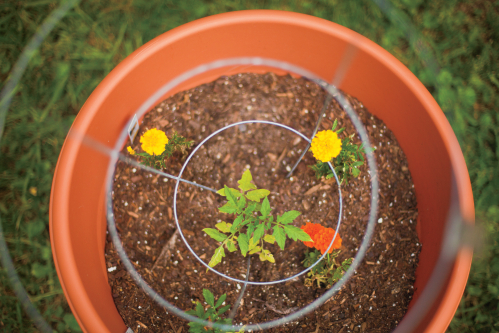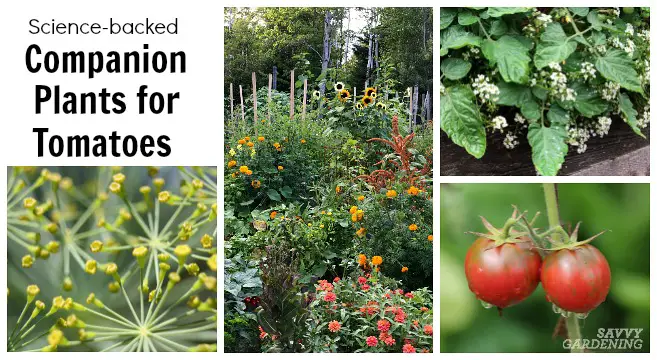Companion planting in containers is the practice of growing two or more plants together to benefit each other. For example, marigolds and tomatoes can be grown together in a container as marigolds repel tomato worms, while tomatoes provide shade for the marigold root system. The same principles apply for companion planting in containers that you would use when gardening on a larger scale – try to pair plants with similar soil and light requirements, or ones that will attract beneficial insects like bees or ladybugs while repelling pests.
Container gardens are also great spaces to experiment with natural pest control by introducing certain herbs such as basil or oregano which can help keep aphids away from your vegetables. Companion planting in containers is an easy way to maximize your yields and create a thriving garden ecosystem!
Companion planting in containers is a great way to maximize the space of your container garden and get more bang for your buck! With companion planting, you can fit more plants into one pot or planter while also providing beneficial support to each other. For example, taller plants can provide shade on hot days for smaller ones, while ground covers help retain moisture in the soil.
You can even add pest-deterrents like marigolds to protect from pests that might otherwise damage other plants.

Credit: tnhomeandfarm.com
Does Companion Planting Work in Containers?
Yes, companion planting does work in containers. Container gardening is a great way to explore the benefits of companion planting without having to commit to an entire garden bed. Companion plants can help provide shade, attract beneficial insects, and repel pests when grown together in a container.
Additionally, some companion plants may act as supports for taller or vining plants by providing structure and stability within the container’s limited space. It’s important to note that you should select smaller varieties of vegetables for your containers since larger varieties need more space for their roots which isn’t always available in a container setting.
What Vegetables Can Be Planted Together in Pots?
Vegetables such as lettuce, spinach, kale, chard and radishes can all be planted together in pots. These types of vegetables have shallow root systems and thrive when grown close to each other. Other suitable vegetables for pot planting include peppers, eggplants, tomatoes, squash and beans.
When growing these vegetables together it is important to keep them separate by using different sized containers or by providing adequate spacing between the plants so they don’t compete for nutrients. Additionally, make sure the pot is large enough to support the size of your desired harvest before planting!
How Close is Too Close Companion Planting?
When it comes to companion planting, there is no definitive answer as to how close is too close. Different plants will have different requirements and needs when it comes to spacing and light levels so the best way to get an accurate answer for your garden would be to research the individual plants you are working with. Generally speaking however, most plants should have a few inches of space between them in order for their roots and foliage not to compete for resources such as water, minerals and sunlight.
Additionally, some vegetables or fruits may benefit from being planted closer together if they act as natural repellents or attract beneficial insects which can offer extra protection against pests – this will depend on your specific situation though so make sure you do your research!
What Vegetables And Herbs Grow Well Together in Containers?
Growing vegetables and herbs together in containers is a great way to save space, as well as to enjoy the benefits of companion planting. Many vegetables and herbs can be grown successfully together; some popular pairings include tomatoes with basil, peppers with oregano, lettuce with chives, spinach with parsley and carrots with dill. When selecting plants for container gardening, it’s important to keep in mind the size of each plant when fully grown.
Additionally, take into consideration different soil needs among companion plants – some may prefer more sandy soil while others need more moisture or fertilizer than their counterparts require. It’s also important to research light requirements for each plant so that they are not competing for sunlight within the same container. By carefully selecting compatible vegetable and herb companions that have similar sun exposure requirements and complementary nutrient needs you can create an abundant harvest right from your own patio!
companion planting in containers: an easy guide for urban gardeners
Plants That Grow Well Together in Pots
Companion planting is an age-old practice that can be beneficial when growing plants together in pots. Certain types of plants, such as tomatoes and basil, enjoy being planted near each other because the basil repels pests from the tomato plant. Other successful pairings for potted plants include chives and carrots, oregano and peppers, sage and onions, marigolds and beans, or parsley and roses.
When combined in one pot these helpful companions enrich the soil for each other while also providing a colorful display!
Vegetable Combination Ideas for Container Gardens
Container gardens are a great way to get creative with your vegetable combinations! With the right amount of sunshine, soil, and nutrients you can create a beautiful and bountiful garden. Consider pairing lettuces or leafy greens with herbs like basil, oregano or chives; tomatoes with peppers; root vegetables such as beets and carrots; squash varieties like zucchini or summer squash; and climbing crops such as pole beans.
You can also mix up colors for an eye-catching display – try planting yellow wax beans next to purple eggplants!
Best Companion Planting Combinations
Companion planting is a great way to create a thriving, sustainable garden. By planting certain plants together, you can improve soil health and attract beneficial insects that will help your garden flourish. Some of the best companion combinations include garlic and roses, beans and corn, marigolds and tomatoes, squash and nasturtiums, cucumbers and sunflowers, beets with onions or kohlrabi.
With careful planning you can maximize growth in your garden while also providing support for other plants in your landscape.
Best Companion Plants
Companion planting is a great way to increase the productivity of your garden. Companion plants help each other in various ways, such as providing shade or nitrogen-rich soil, attracting beneficial insects and repelling harmful pests. When selecting companion plants for your garden, consider their size, spacing requirements and growing conditions.
Additionally, think about how they will interact with each other; some plants may not get along! Common companion plant pairings include tomatoes and basil, squash and corn, beans and carrots – but there are many more combinations you can try out!
Do Companion Plants Need to Be in the Same Container
No, companion plants do not need to be in the same container. They can be planted separately and still benefit from one another. Companion planting is a technique used by gardeners to pair certain types of plants together that are known to have a positive effect on each other’s growth or health.
For example, some plants will act as natural pest repellents for others when placed near them, while others may help improve soil nutrition and drainage for their companions.
Companion Plants for Tomatoes in Containers
Companion planting is a great way to maximize the health and productivity of your tomato plants in containers. Some good companion plants for tomatoes include basil, marigolds, oregano, parsley, chives, borage and nasturtiums. These companion plants are known to help ward off pests and diseases as well as attract beneficial insects that help pollinate the flowers on your tomato plant.
Additionally, you can use these companion plants to create a more aesthetically pleasing garden container!
Conclusion
Companion planting in containers is an effective gardening technique that can be used to enhance the health and production of plants and vegetables. It reduces pests, increases yields, and allows for more efficient use of space. The benefits are clear – container gardens are easier to maintain, require fewer resources, provide higher yields and result in a healthier garden ecosystem overall.
With careful planning and attention to detail, companion planting in containers can be a great way to get the most out of your garden!




